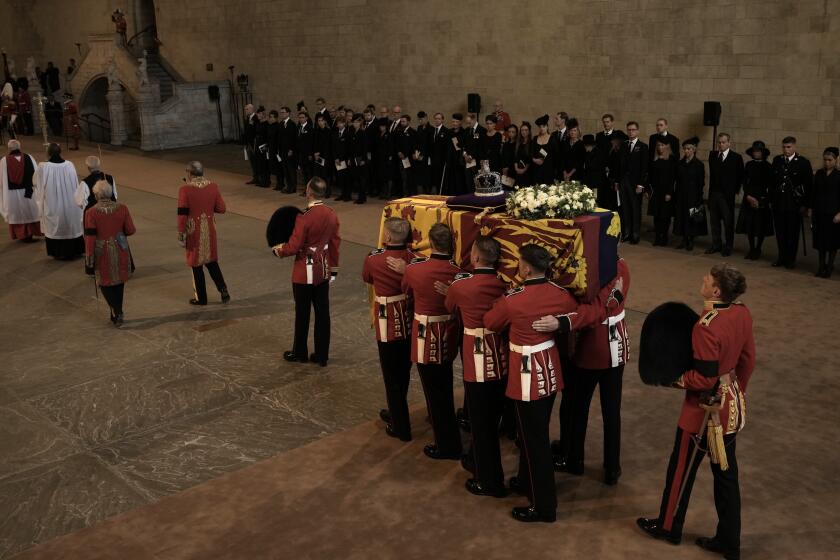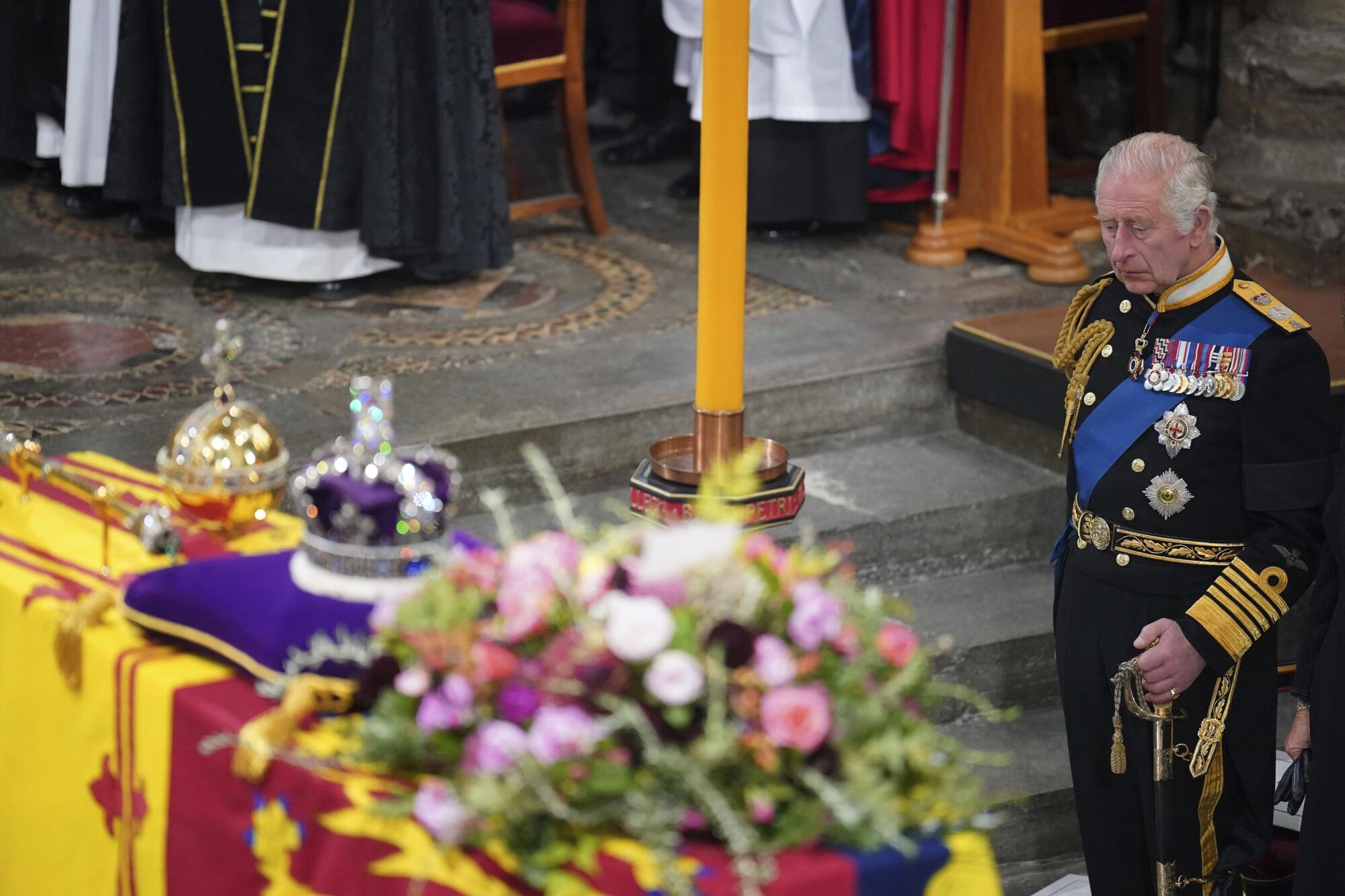
- Share via
The funeral of Queen Elizabeth II of Britain, who died Sept. 8 at 96, took place Monday morning in Westminster Abbey, site of the coronation and burial of English and British monarchs for nearly 1,000 years. As The Times reported Friday, the event is the nation’s largest-ever security operation. It was also expected to draw a global television audience.
From the place of her death, Scotland’s Balmoral Castle, the U.K.’s longest-reigning sovereign transited over the last 11 days through Edinburgh and London to Buckingham Palace and thence to the Houses of Parliament, where her casket lay in state from Wednesday till early Monday, attracting hundreds of thousands of mourners.
Elizabeth’s casket is being transferred to Windsor Castle and will be interred in the royal vault with her sister, Princess Margaret; mother, Queen Elizabeth; and father, King George VI.
The Times provided live updates from around the globe: Nabih Bulos, Henry Chu and Christina Boyle reporting from London along with Eli Stokols, traveling with President Biden; Marcus Yam in Windsor; Parth N.M. in Mumbai; and Meredith Blake and Mary McNamara, who followed the television coverage from New York and Los Angeles, respectively.
Dignitaries read protocol arrangements like tea leaves amid speculation over the guest list at Queen Elizabeth II’s funeral.
5:15 a.m. I am struck by the image of the household staff in their simple uniforms lined up outside Buckingham Palace. For all the pomp and circumstance of this day, it’s powerful seeing the people who quietly toil away behind the palace gates. —MB
4:53 a.m. The stately tolling of Big Ben, the famous bell inside the clock tower next to the Houses of Parliament, could be heard over the gun salute and the music of the military band accompanying the gun carriage bearing the queen’s coffin.
The bell failed to sound as expected Sunday night to mark the national minute of silence observed for the late monarch. But the problem appears to have been fixed.
The tower was known as the Clock Tower until 2012, when it was renamed the Elizabeth Tower in honor of the queen on the occasion of her Diamond Jubilee, celebrating 60 years on the throne. —NB
4:49 a.m. Given all the consternation over whether Prince Andrew and Prince Harry got to wear military attire for today’s funeral, it’s interesting that Princess Anne is in ceremonial naval uniform today, though she has never served in the military. Known as one of the least showy and hardest-working members of the royal family, Anne, 72, holds the honorary rank of rear admiral and has numerous decorations. It’s tempting to think about what today might have looked like if she were succeeding her mother instead. —MB
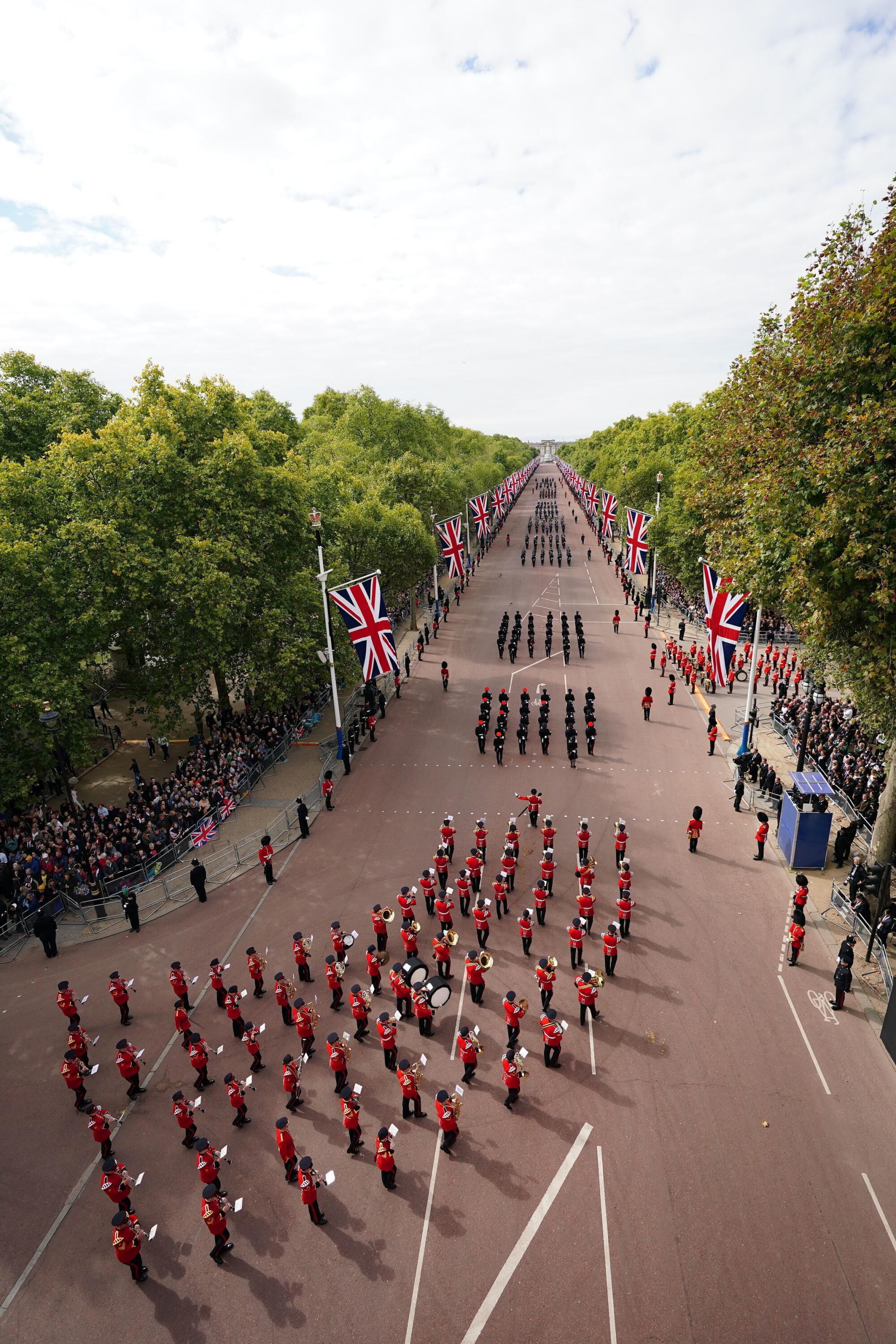
4:46 a.m. After the funeral, the outdoor tables at the City of Quebec pub just across from the park filled up quickly.
“To the queen,” a group of three friends said as they toasted Guinness pints and watched ongoing BBC coverage of the procession on a cellphone.
“It was an impressive crowd, and they stayed silent for all two minutes, which was good,” said Zoe Dearsley.
Reflecting on “the end of an era,” Dearsley marveled at the queen’s seven decades of service. “She served for all that time with such grace. To be 96, two days from death and still doing her duty, meeting with Boris Johnson and Liz Truss, probably the last thing she wanted to do, it’s just remarkable.”
Her boyfriend, Dan Ellis, said that, as a native South African, he’s always been somewhat less enamored of the crown than many Britons, but still recognized the queen’s seven decades of service.
“I’m somewhat skeptical of monarchy generally, but she had such character,” he said. “She was the best of leadership.” —ES
4:44 a.m. Service members are marching with their guns reversed as a sign of mourning. Big Ben continues to toll, and a gloomy morning has become a sunny afternoon. Which, while not on par with the rainbows that appeared over Buckingham Palace just before the queen’s death was announced and then later as she lay in state, does seem to capture the day’s mixture of sorrow and gratitude. —MM
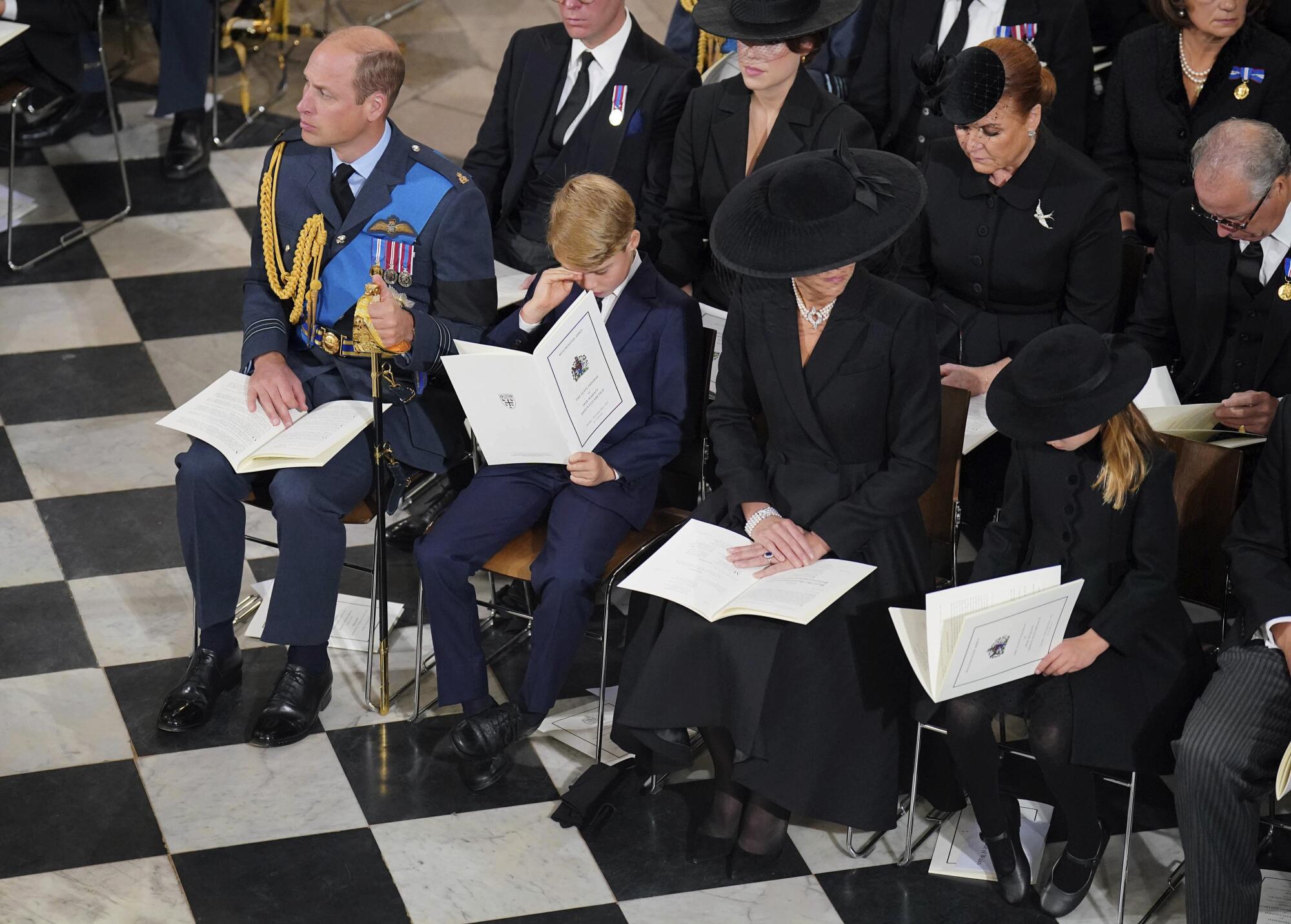
4:29 a.m. In Windsor, where the queen will be interred later Monday, a crowd stood up as one when “God Save the King” was sung toward the end of the funeral, which was projected on large screens. Many people took off their hats. One man was draped in the British flag.
Along the tree-lined avenue leading to Windsor Castle known as the “Long Walk,” more than 100 police officers in traditional black-and-white uniforms took up positions to keep the peace. —MY
4:25 a.m. In such a large crowd, it’s the crowd itself that you feel — all those people, together in silence, watching the large screens, sharing in a historic moment. But there are a few images I’m remembering now as folks begin to head away from the gathering: the small children perched on their parents’ shoulders, a woman holding her dog over her shoulder, the long line at the ice cream stand.
Beneath a tree toward the back of the lawn, people had left some bouquets of flowers by a cutout of Paddington Bear. A note attached to a wreath of roses read: “To our dear Queen Elizabeth II, You kept your promise. Rest In Peace.”
I noticed a few people wiping away tears, but emotional outpourings, at least on the surface, were harder to see. This seemed to be more about marking a moment, saying goodbye and, above all, affirming a national connection — to the queen, yes, but also to one another. —ES
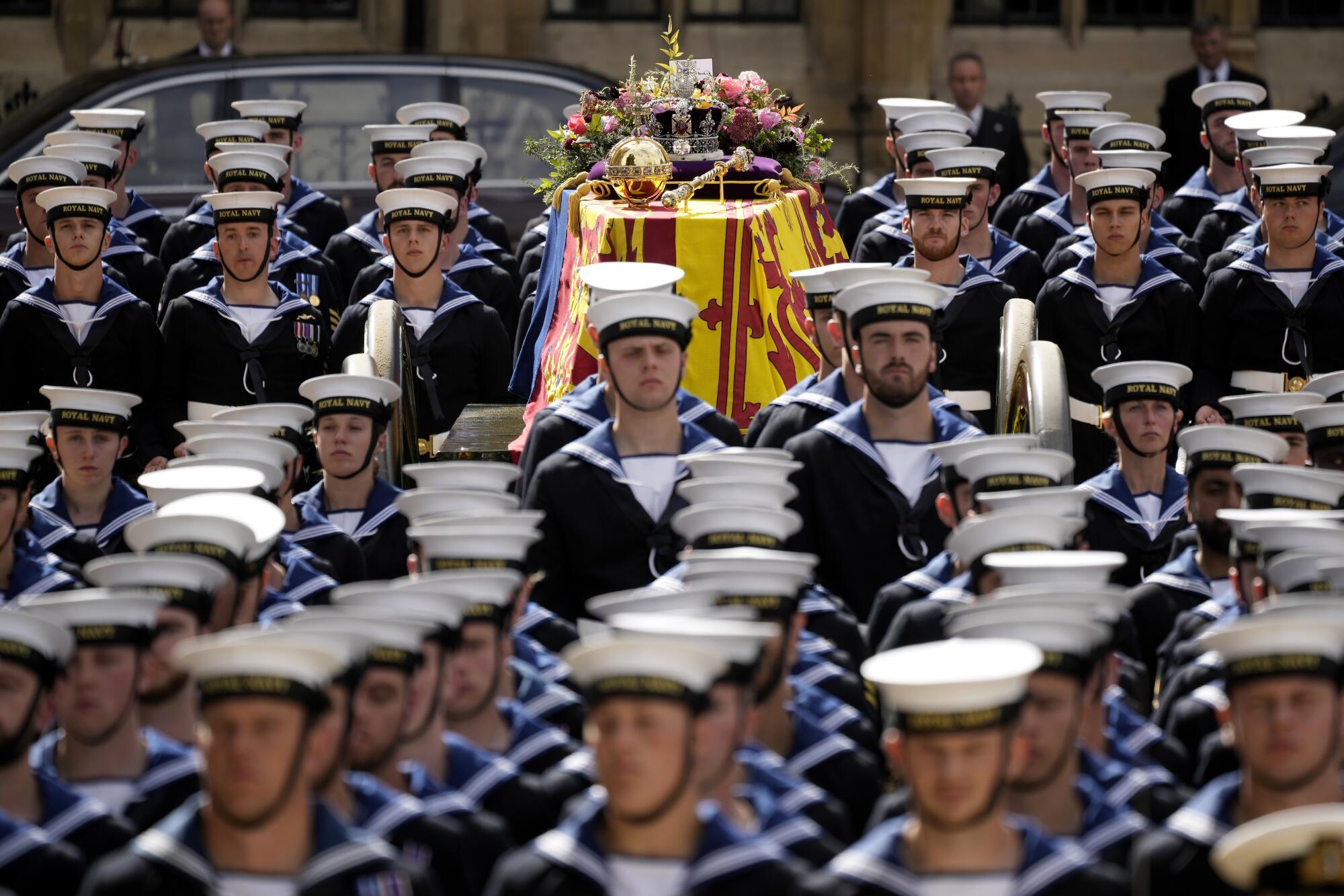
4:20 a.m. The queen’s coffin will be drawn on a gun carriage for a procession through central London to the Wellington Arch, where it will be transferred to a hearse for the drive to Windsor.
Smaller services attended by those closer to the late sovereign will take place there before she is laid to rest next to her husband, Prince Philip, who died last year. —HC
4:19 a.m. Per CNN, which is in full commentary mode during the recessional because, no doubt, organ music, the note atop the queen’s coffin reads: “In loving and devoted memory, Charles R.” On BBC, Fergal Keane, who has been a lyrical and soothing presence during that network’s commentary, quotes Wordsworth. —MM
4:13 a.m. Barely an hour after it began, the service at Westminster Abbey is now coming to an end. It feels, somehow, too brief for someone who reigned for so long, yet also efficient in a way befitting Elizabeth. —MB
4:10 a.m. During the two minutes of silence at the conclusion of the funeral inside the abbey, a hush fell over the crowds in Hyde Park, where many stood with heads bowed, their faces solemn. No one moved.
Though this is a quintessentially British occasion, the queen’s funeral has drawn people from all over the world. Walking through the masses of people gathered in London to be part of the event, you hear snatches of Italian, Chinese, Thai, Spanish — an illustration of the worldwide appeal of a monarch who for many embodied the spirit of service. —NB
4:07 a.m. King Charles III, who is 73, spent nearly his entire life singing “God Save the Queen.”
He will never sing the national anthem again, as it is now about him. Thus he stood silent while everyone else in Westminster Abbey sang “God Save the King.” —HC
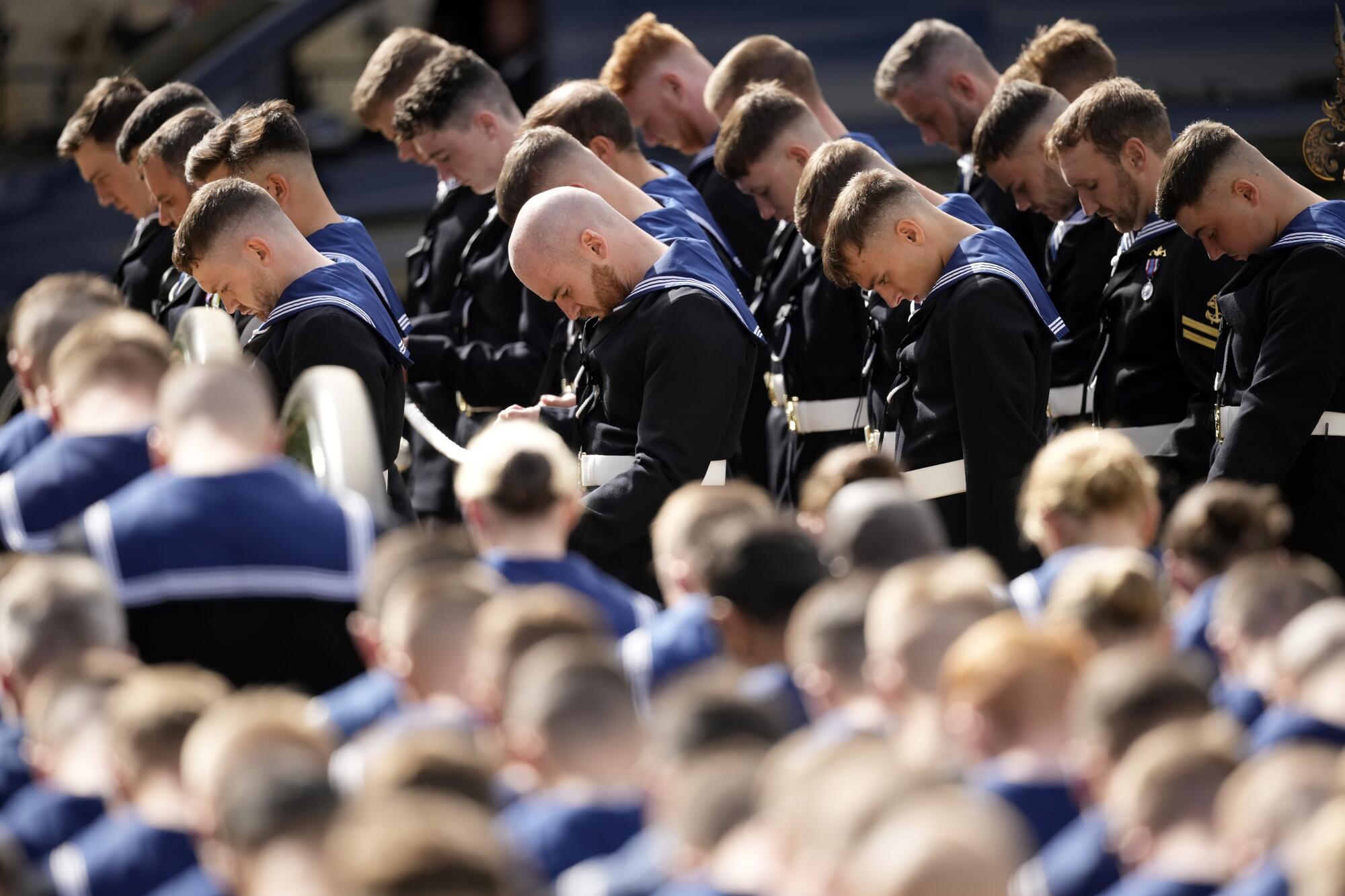
4:05 a.m. The eight pallbearers were chosen from the Queen’s Company 1st Battalion Grenadier Guards, some of whom were summoned home from Iraq on the day of the queen’s death. They will accompany her coffin to Windsor and remain the Queen’s Company until she is laid to rest, after which they will become the King’s Company. —MM
4:00 a.m. Takeoffs and landings at London’s Heathrow Airport, one of the world’s busiest, are being suspended for half an hour so that no overhead noise disrupts the two-minute of silence to be observed at the end of the queen’s funeral.
British Airways said it reduced the number of its flights and rescheduled some of them.
The skies were also cleared over Heathrow on Wednesday during the procession of the queen’s coffin from Buckingham Palace to Westminster Hall for its lying-in-state. —HC
3:52 a.m. London resident Carita Soutter created a mural on the wall outside her London home and left a note and pot of chalk encouraging others to leave their own drawings.
The wall is now covered in red, white and blue hearts beneath the words “RIP Lilibet” — the queen’s childhood nickname.
“It’s now full of hearts and really beautiful,” Soutter said.
Soutter and her family are watching the funeral service quietly at home now and plan to cycle to Chiswick, in west London, later to see the queen’s coffin make its way to Windsor, her final resting place.
“We want to pay our respects as she goes by,” Soutter said. —CB
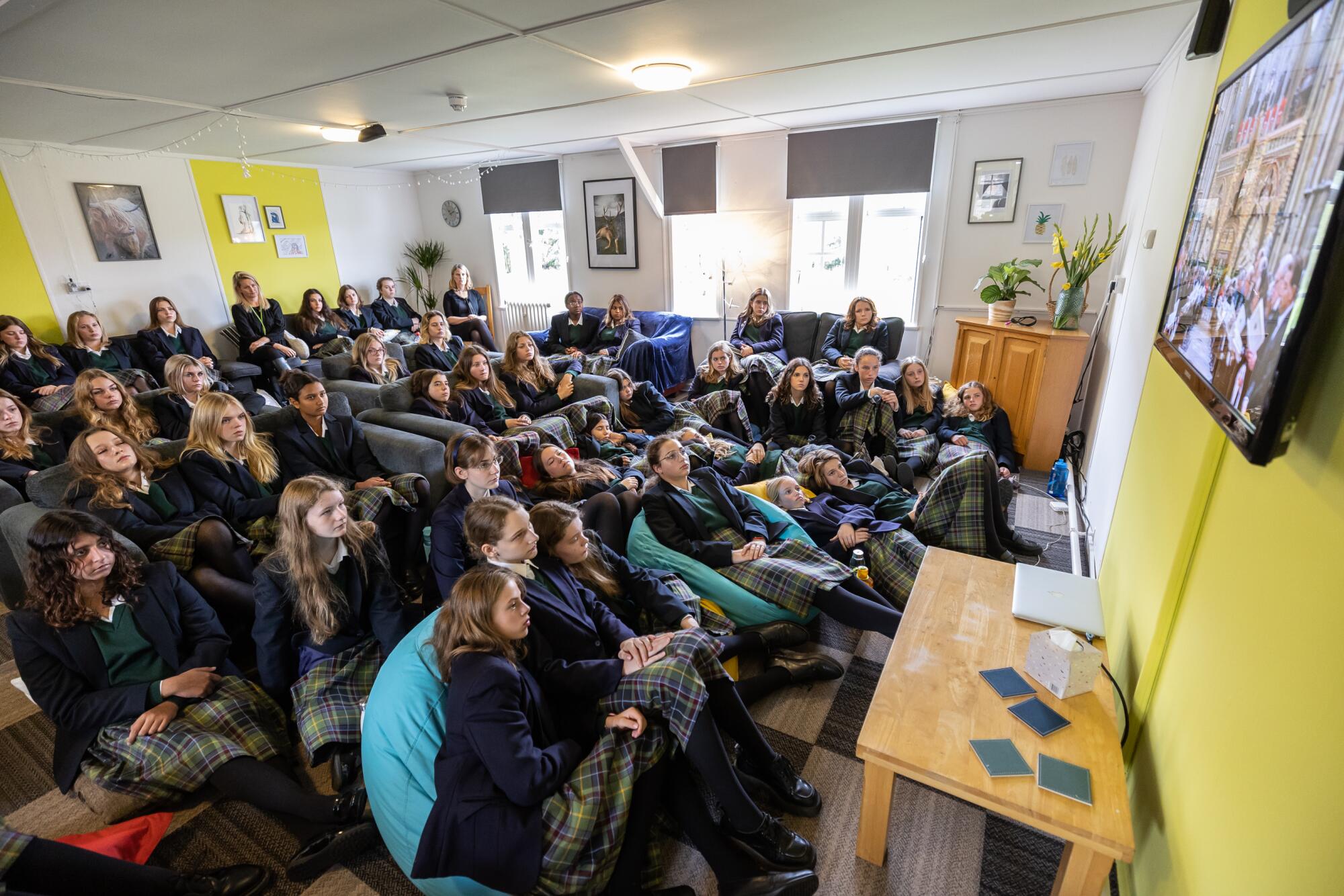
3:49 a.m. This post is a few minutes behind because of a lack of cell service in the park, but I was struck by one thing that just happened: When the congregation inside Westminster Abbey stood for the first hymn, the entire crowd here in Hyde Park also rose up from their blankets and lawn chairs. They remained standing until the hymn finished and everyone inside the official funeral sat back down. Beyond just coming here to share in this day of national mourning and remembrance, the people here are participating as much as possible in the funeral and surrounding rituals. —ES
3:46 a.m. Though other parts of London had coffee shops open, with residents jogging, walking their dogs or simply enjoying an unexpected public holiday, the environs of Buckingham Palace were deluged with people hoping to witness history.
That spirit was well on display on the route from there to Hyde Park, with street vendors making brisk business selling little flags and flower bouquets. The atmosphere seems to be a celebration of all things Brittania, with hats, shawls, flags and other knick-knacks featuring the Union Jack. —NB
3:44 a.m. Flowers and foliage from Buckingham Palace, Clarence House and Highgrove House top the queen’s coffin, including rosemary for remembrance, English oak for love and myrtle for a happy marriage. This myrtle was cut from a plant grown from a sprig of myrtle that was in the queen’s wedding bouquet when she married Prince Philip in 1947. By the queen’s request, the wreath is sustainable, with no foam used. —MM
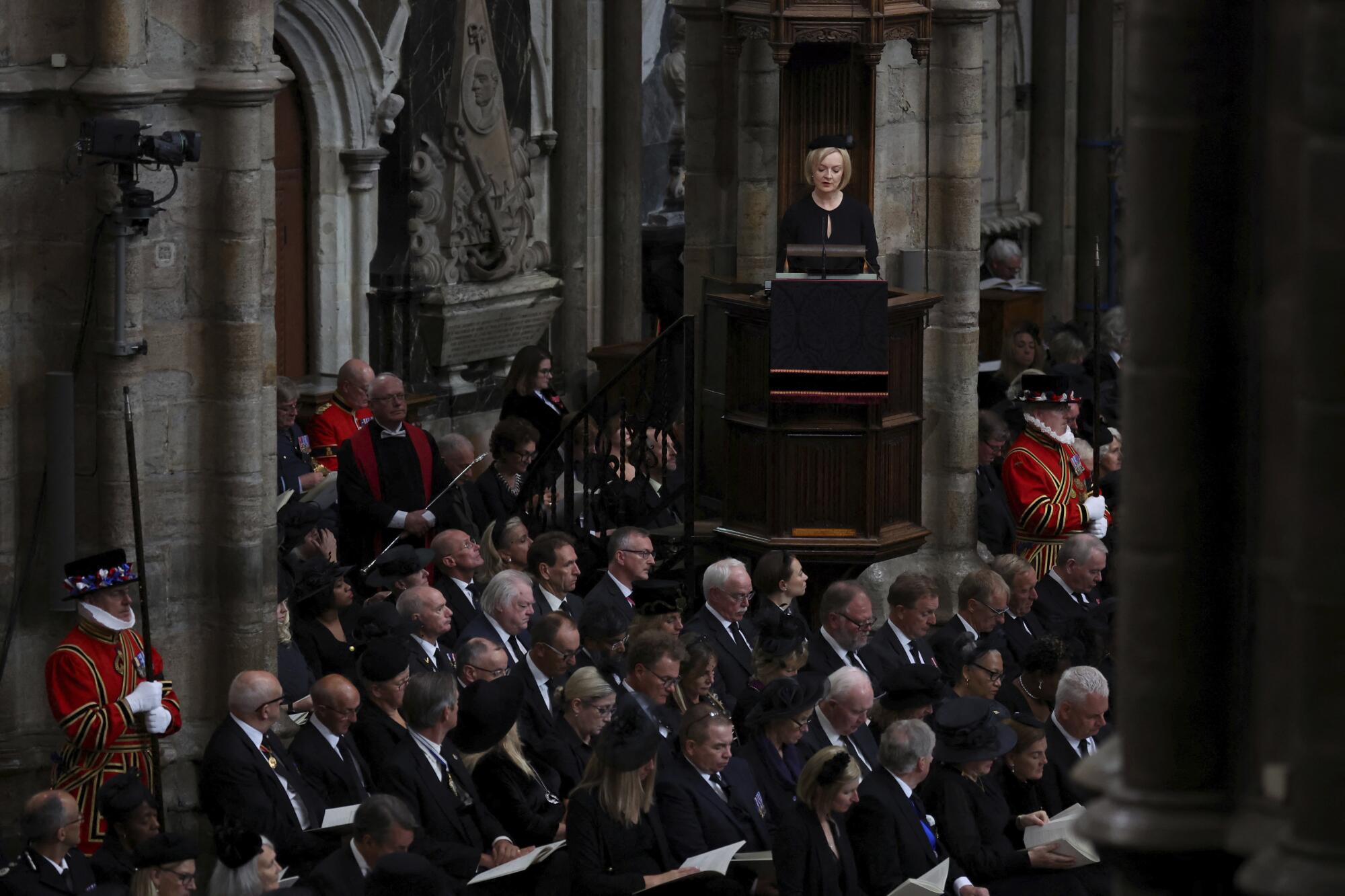
3:42 a.m. Archbishop of Canterbury Justin Welby ended his homily with the words “We will meet again,” an echo of a message delivered by the queen during the COVID-19 pandemic to comfort the many people who lost loved ones.
Her use of the phrase was itself drawn from the song “We’ll Meet Again” by Vera Lynn, an iconic piece in Britain from World War II.
Its famous refrain goes:
We’ll meet again
Don’t know where
Don’t know when
But I know we’ll meet again some sunny day —HC
3:31 a.m. American networks wisely seem to be following the lead of the BBC and refraining from commentary during the service. On NBC, captions list the hymns and Scripture readings. —MB
3:28 a.m. Prime Minister Liz Truss gives the second reading. Truss is Britain’s third female premier, and was formally invited by the queen to take the post just two days before she died.
Truss, 47, previously met some of the other political leaders in attendance at the funeral during her tenure as Britain’s foreign secretary.
Although some analysts say she could receive a bounce in the polls for the government’s handling of the queen’s death, she faces a formidable list of challenges afterward, including a cost-of-living and energy crisis that has many Britons hugely concerned over their ability to get through the coming winter. —HC
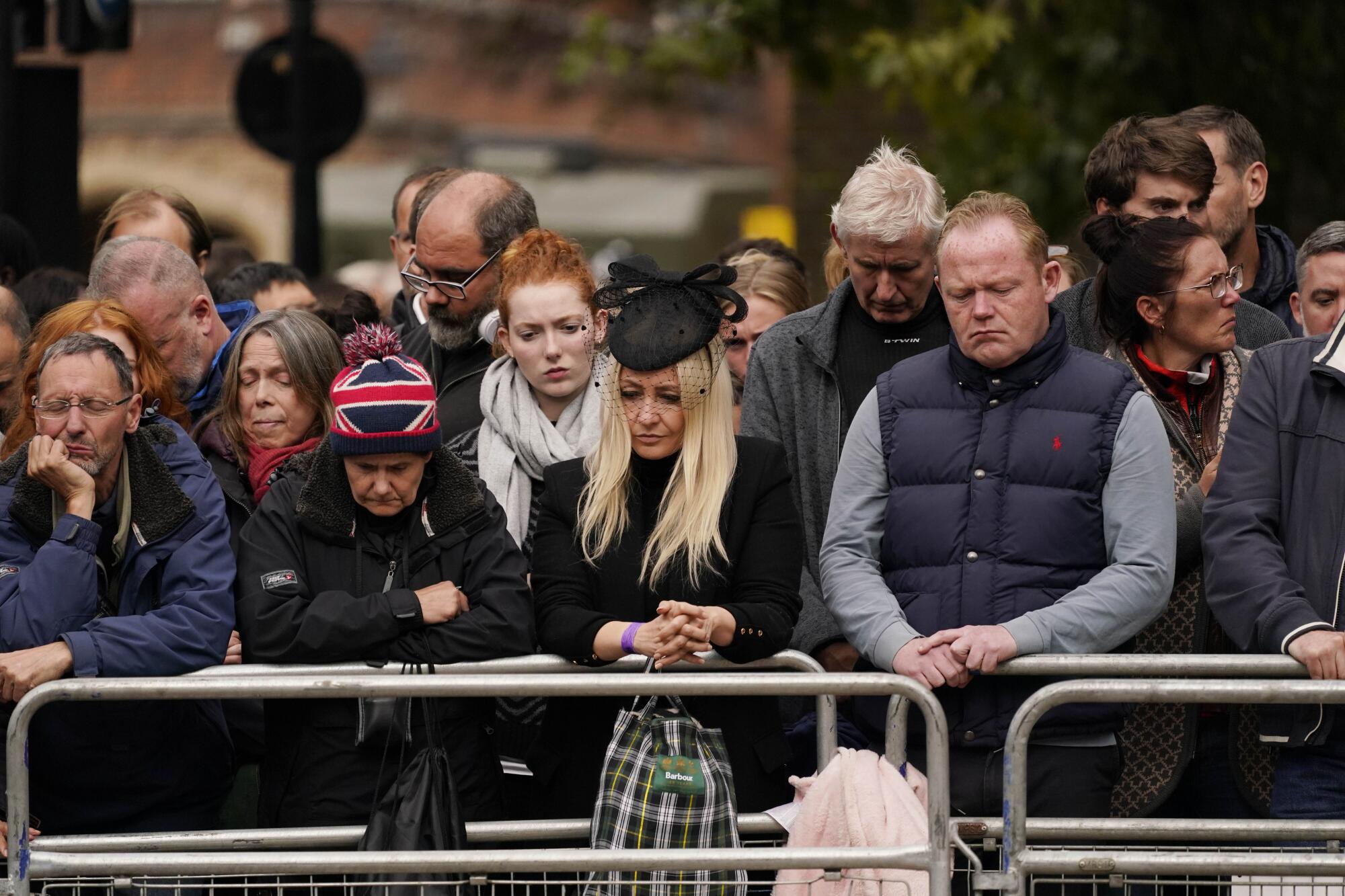
3:24 a.m. Speaking to NDTV, Dr. Rajay Narain, director of the Global Health Alliance, U.K., said he has never seen anything like this.“The response has been overwhelming. The younger generation has lined up. That is great. The queen carried herself gracefully over the years. And had a huge connect with the masses in the U.K. There is a big gap that has happened because of her passing. Prince Charles, now the king, will have to fill in those shoes. It will be a huge challenge for anybody because of the way she performed her duties over several decades.” —PMN
3:22 a.m. Patricia Scotland, who gave the first Scripture reading of the funeral, has the distinction of being Britain’s first Black female “queen’s counsel,” a specially chosen group of lawyers who have practiced law for at least 10 years.
Scotland, who was made a baroness, is also secretary-general of the Commonwealth, an organization of more than 50 nations that were previously part of the British Empire.
The “QCs” are now “KCs” — king’s counsel — with the accession of King Charles III. —HC
3:16 a.m. India’s complicated history with the U.K. notwithstanding, mainstream media channels have started telecasting the queen’s funeral. News channels across ideological divides have moved to the funeral, including Republic, a far-right channel and vocal supporter of Narendra Modi’s authoritarian rule, and NDTV 24*7, a staunch critic of Modi. It indicates that the English-speaking urban Indian is interested in the ceremony regardless of ideology. Many feel familiar with the queen due to the Netflix show “The Crown.” “I know many people who had no sense of the British royal family, but they watched ‘The Crown,’ were addicted to the show and also connected with Queen Elizabeth on an emotional level,” Aseem Chhabra, author and director of the New York Indian Film Festival, told The Times. “These people were young when Princess Diana died. But the Netflix show gave them a human perspective of the royal family, especially the late queen.” —PMN
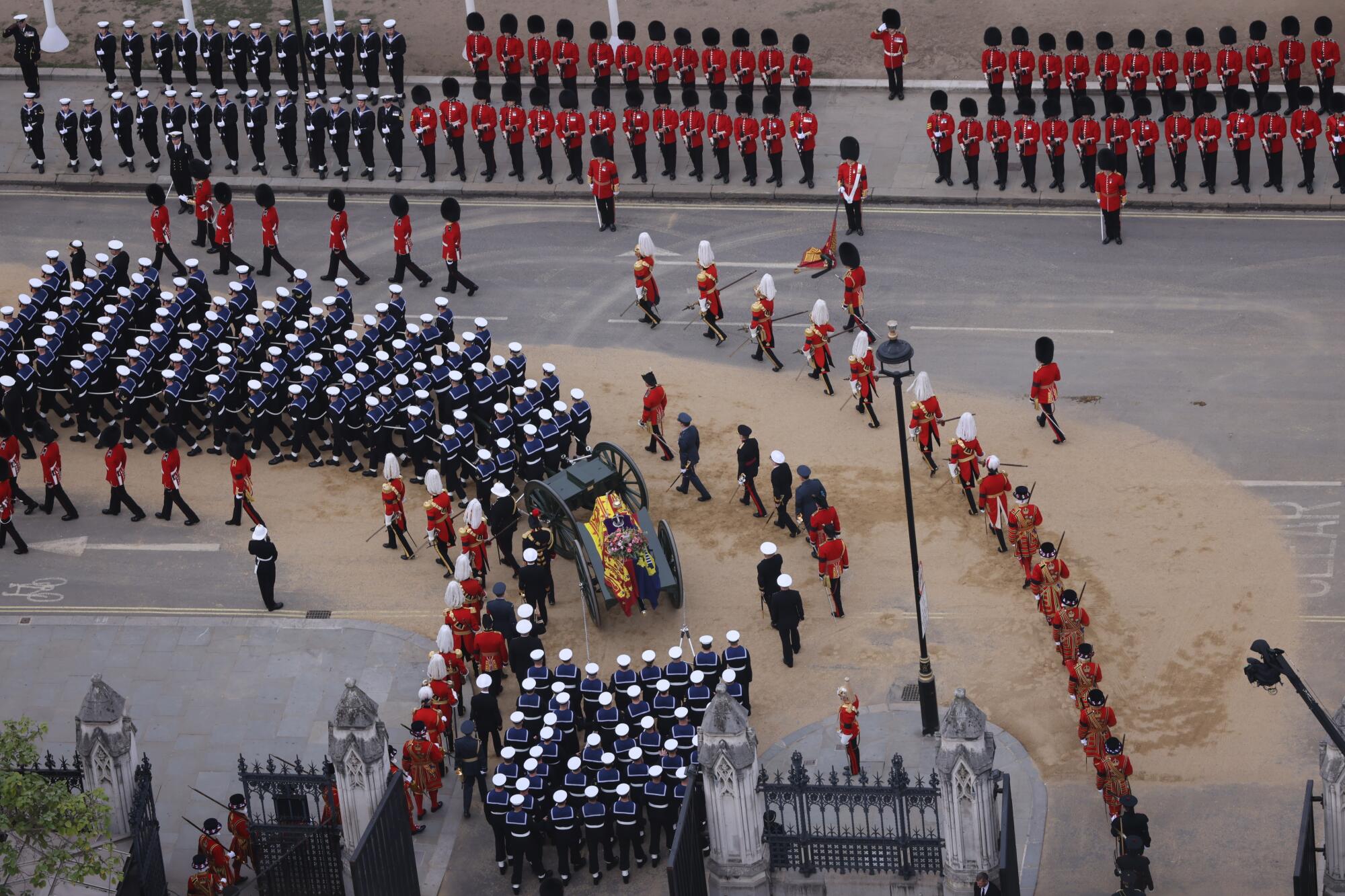
3:10 a.m. In a pub in London’s Chinatown, less than a mile from Westminster Abbey, a large projector screen is broadcasting the funeral live.
About a dozen people stood in the bar area watching the procession get underway. No one said a word. A few people had pints of beer in hand, but the atmosphere was very somber.
Caitlin Rose, 19, traveled to London at 4:30 a.m. from Wales with a friend. They were avoiding the epicenter of the funeral procession because of security concerns but still wanted to be in the capital. They were lured into the pub by the sound of the marching band on TV.
“We’re trying to avoid the area near the funeral because of how busy it is, but we just came here for the atmosphere,” she said. “And because we’re not going to have another female monarch for a while.” —CB
3:08 a.m. Imagine the pressure of being a pallbearer for the queen. —MM
3:03 a.m. There is a formidable police presence around London, with security stewards in high-visibility jackets at every turn.
The funeral, with the many heads of state in attendance and thousands of people in the streets, is the biggest security operation in British history.
The Metropolitan Police, also known as Scotland Yard, has deployed 10,000 officers around the British capital. —CB
2:57 a.m. The BBC announced earlier that, due to the nature of the day, it would not be providing commentary during the procession — information about who is participating can be found on its website. It was absolutely the right decision. The bell tolls again and again. —MM
2:56 a.m. Indian Prime Minister Narendra Modi had announced nationwide mourning after the passing away of Queen Elizabeth II. The flags were at half staff. The decision had met with mixed reactions due to India’s complicated history with Britain. Political leaders and celebrities had expressed their sadness, while many pointed out the looting and plunder of colonial rule. Saiyid Zaheer Husain Jafri, professor of medieval Indian history at Delhi University, said the British authorities have always ill-treated the royal houses in India. “The monarchy cannot be detached from this history,” he told The Times. “The colonial rule has left India with legacies we are still struggling with. The British looted India for 200 years.” —PMN
2:52 a.m. As the funeral procession begins, a hush has fallen over Hyde Park. Rarely have I seen a crowd of this size so quiet. Everyone is watching the queen’s coffin being escorted into Westminster Abbey. Several people are holding up phones, capturing the events broadcast on the large screens. But a majority of this crowd is just sitting silently, absorbing the moment. —ES
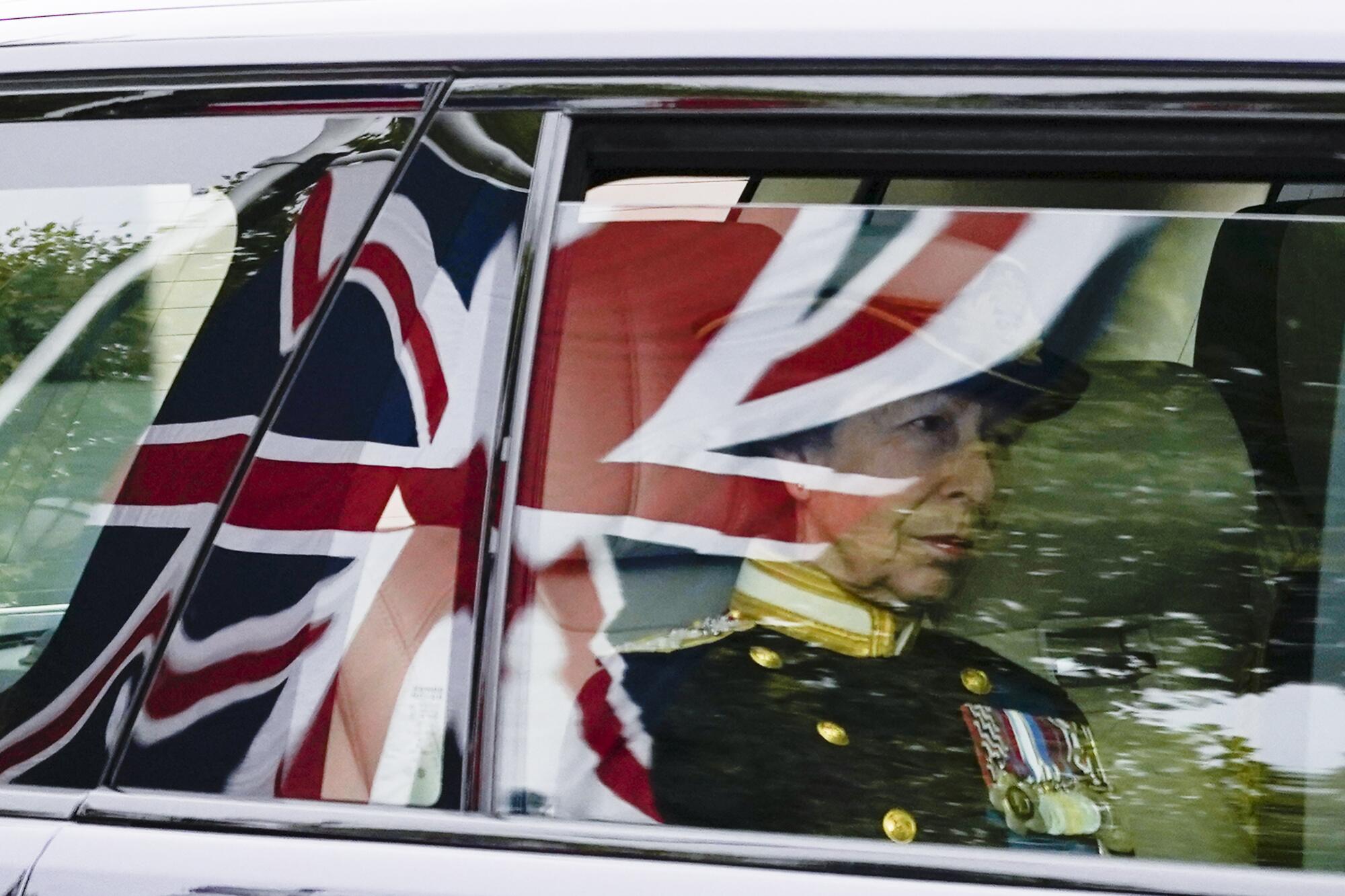
2:51 a.m. The tenor bell tolling once a minute for 96 minutes, to mark each year of the queen’s life, is Westminster Abbey’s largest — and heaviest — bell.
It has a diameter of 4½ feet, weighs more than 1½ tons and is tuned to the note of D.
It tolls whenever a member of the royal family dies and also when the dean of the abbey dies. —HC
2:48 a.m. Catherine, the Duchess of Cambridge, enters Westminster Abbey with two of her three children, Prince George and Princess Charlotte. The youngest, 4-year-old Prince Louis, is, mercifully, at home. I can’t help but wonder if Kate has sweets tucked away in her pockets to keep them silent during the service. The scrutiny she must be under, wrangling kids at a once-in-a-lifetime royal funeral. —MB
2:46 a.m. It is a sad, solemn occasion, but I have to say it is still striking to see such a large group of people sitting patiently for so long without a smartphone in sight. In a way, that is just as remarkable as all the robes and uniforms, a return to a different time, the ultimate sign of respect. This being Britain, there are a lot of hats, but they are small and subdued. There is a remarkable grace to the crowd, which is filled with world leaders, sorrow but not tragedy. It is a gathering to honor as much as to mourn. Her reign has no comparison and almost defies context; we will never see anything like this, or Elizabeth II, again. The bell is still tolling, and as the queen’s coffin is placed on the gun carriage, the silence is overwhelming. —MM
2:44 a.m. Lesley Cole and her family were a little bleary-eyed as they sat on a train into central London hoping to be part of Queen Elizabeth II’s funeral and soak up the atmosphere.
Cole’s group included her daughter, her daughter-in-law and three granddaughters. On Sunday, they had waited 12 hours to see the queen’s coffin in Westminster Hall. The youngest of the group, Delainie White, 9, said it felt important for her to be there to pay her respects.
“I wanted to be here to be part of history. I curtsied in front of her coffin,” she said.
On Monday, the three generations of women and girls planned to lay flowers in Green Park.
“I don’t think anybody is going to fill her shoes,” Cole, 68, said of the queen. “She just had that serenity.” —CB
2:39 a.m. Dan and Kayleigh Schofield took the train from just outside London to Hyde Park to watch the queen’s funeral on the lawn with their two young daughters. The girls sat on a blanket in matching dresses coloring with crayons, ignoring the BBC coverage on the big screens showing world leaders arriving at Westminster Abbey, while their parents took it all in.
“She just summed up what the country was, and what it means to be British,” Dan said of the queen. “We just wanted to pay our respects and for our kids, when they’re older, to be able to say they were here.”
The monarchy, he went on, trying to explain his need to be here, “is something because people make it something. We’re all part of it.”
Kayleigh, who said she laid flowers at Buckingham Palace last week, marveled at Elizabeth’s lifelong commitment to her role and the commonwealth: “She’s just been inspiring. A true leader.” —ES
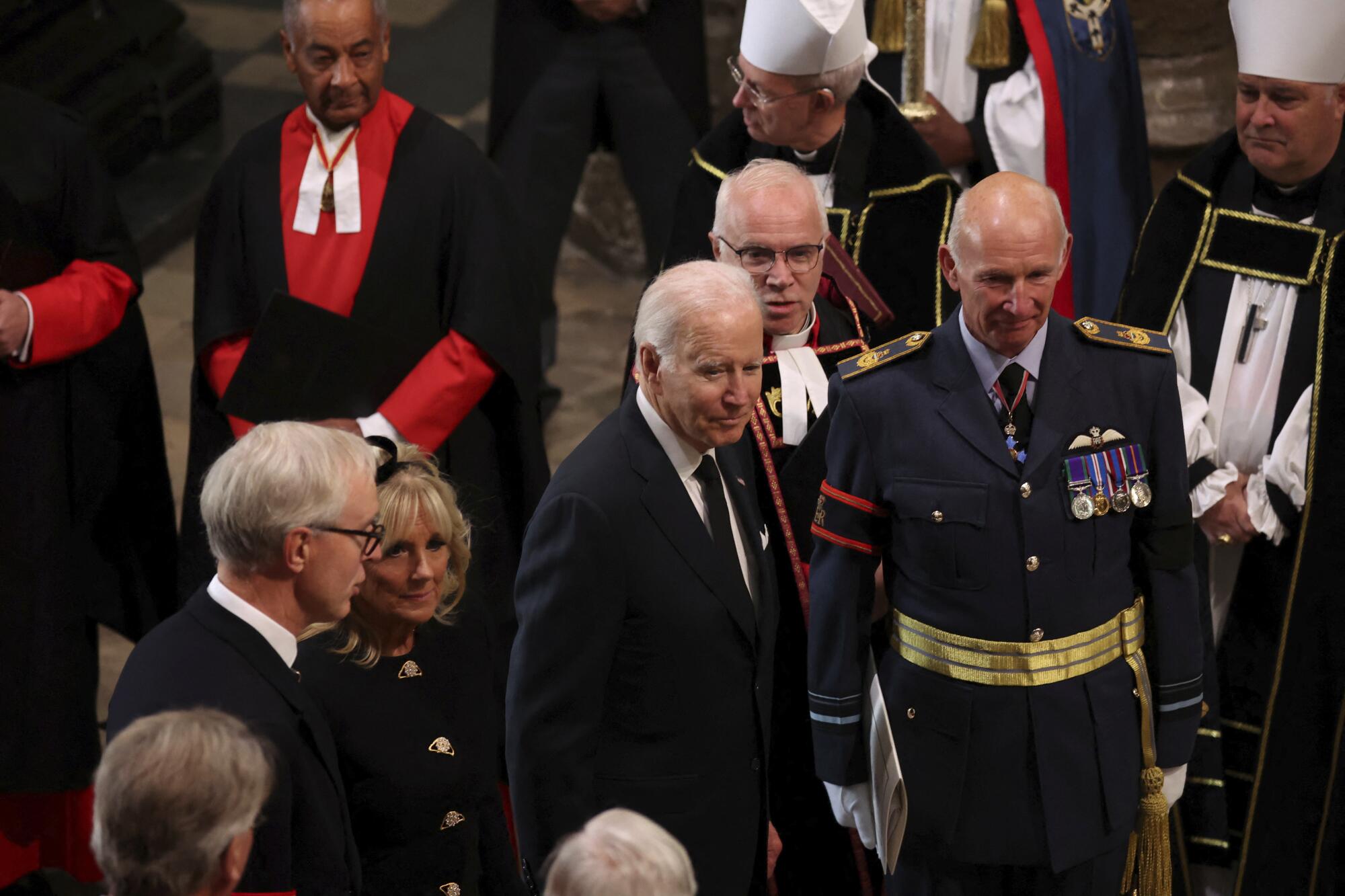
2:34 a.m. In the quiet streets of southwest London, dog walkers, runners and cyclists were heading to Richmond Park, but there was little other activity.
The roads were quiet, shops and cafes were nearly all shut, and a few people could be seen walking briskly to the nearby train station dressed in black. A small grocery store was the only place open, and the counter inside was covered in the morning’s papers.
“It’s very quiet,” the owner said. “We’ve sold a few newspapers but not much else.”
He said his store would be closing from 11 a.m. to 12 p.m., the hour of Queen Elizabeth II’s funeral service, as a mark of respect, and also because he wanted to watch the service himself.
“Hopefully it will be a bit busier this afternoon,” he said. —CB
2:26 a.m. It’s not only British royalty in attendance at Queen Elizabeth II’s funeral. Other crowned heads of Europe are expected in the abbey to bid farewell to one of their peers, including King Felipe VI of Spain and his wife, Queen Letizia, and King Philippe of Belgium and his wife, Queen Mathilde.
With Elizabeth’s death, all of Europe’s reigning monarchs are men, with the exception of Queen Margrethe II of Denmark, who has ruled for 50 years and is now the continent’s longest-serving head of state.
From outside Europe, Emperor Naruhito of Japan and his wife, Empress Masako; King Jigme Khesar Namgyel Wangchuck of Bhutan; and Haji Hassanal Bolkiah Mu’izzaddin Waddaulah, the Sultan of Brunei are also on the guest list.
If the natural order holds, the British throne will be occupied by kings (Charles, then his son William, then William’s son George) for decades to come. That could mean some changes. —HC
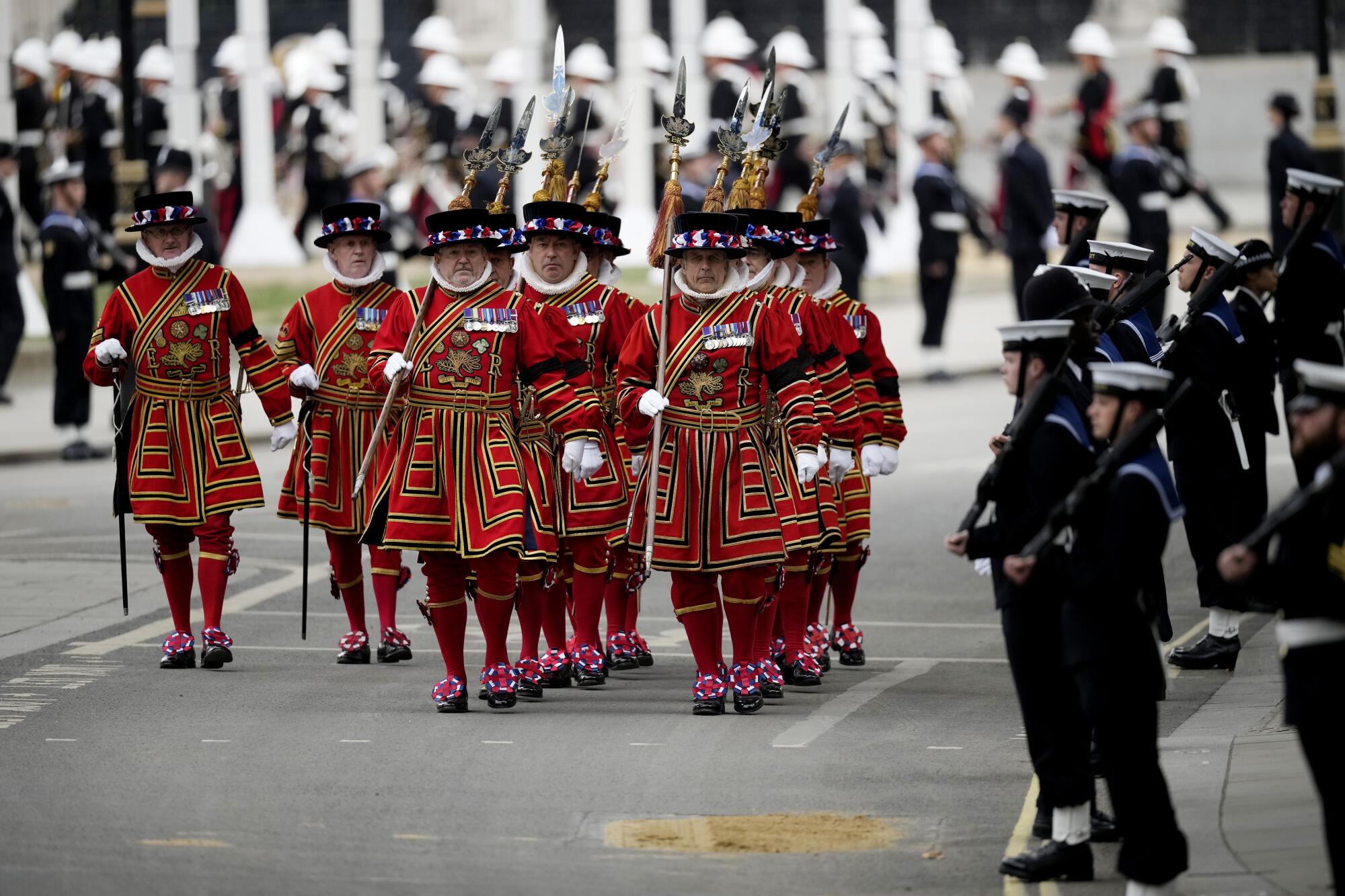
2:17 a.m. Not all Britons are flocking to central London or remaining glued to their television screens. Tina Thorpe, a Londoner, will be taking her dog to have its teeth seen to. She might turn on the TV later to see highlights of the funeral coverage, but that’s about it.
“I think it’s going overboard,” said Thorpe, 62. “People are saying, ‘This is a moment in history and we have got to mark it by standing in a queue for 24 hours and see a box with a flag on it.’ It’s interesting, but I don’t like the endless royal commentary.”
“We are being told how to mourn,” she added.
Thorpe said she enjoyed celebrating the queen’s Platinum Jubilee in the summer and organized a street party, but that was more about the community coming together. And the queen’s death has elbowed aside all other news.
“What is going on in Pakistan? What’s going on in the rest of the world? What about Ukraine?” —CB
2:14 a.m. In London on Monday, streets are mostly empty, nearly all stores shuttered, the only sound that of helicopters hovering above. But thousands are streaming into Hyde Park, gathering on the lawn in view of several large projector screens that will broadcast the queen’s funeral.
Two sisters, Angie and Maureen Judge, said they got up in the middle of the night, worried about getting in. Both wore new white T-shirts with the words “Forever in our hearts” printed above the queen’s face.
“Just wanted to be here,” Angie said. “Didn’t feel right sitting at home.”
The monarch’s death, she said, has been “devastating,” akin to losing a close family member.
“We’re in our fifties and she’s just been a part of our lives forever,” Angie continued. “It’s not going to be the same ever again.” —ES
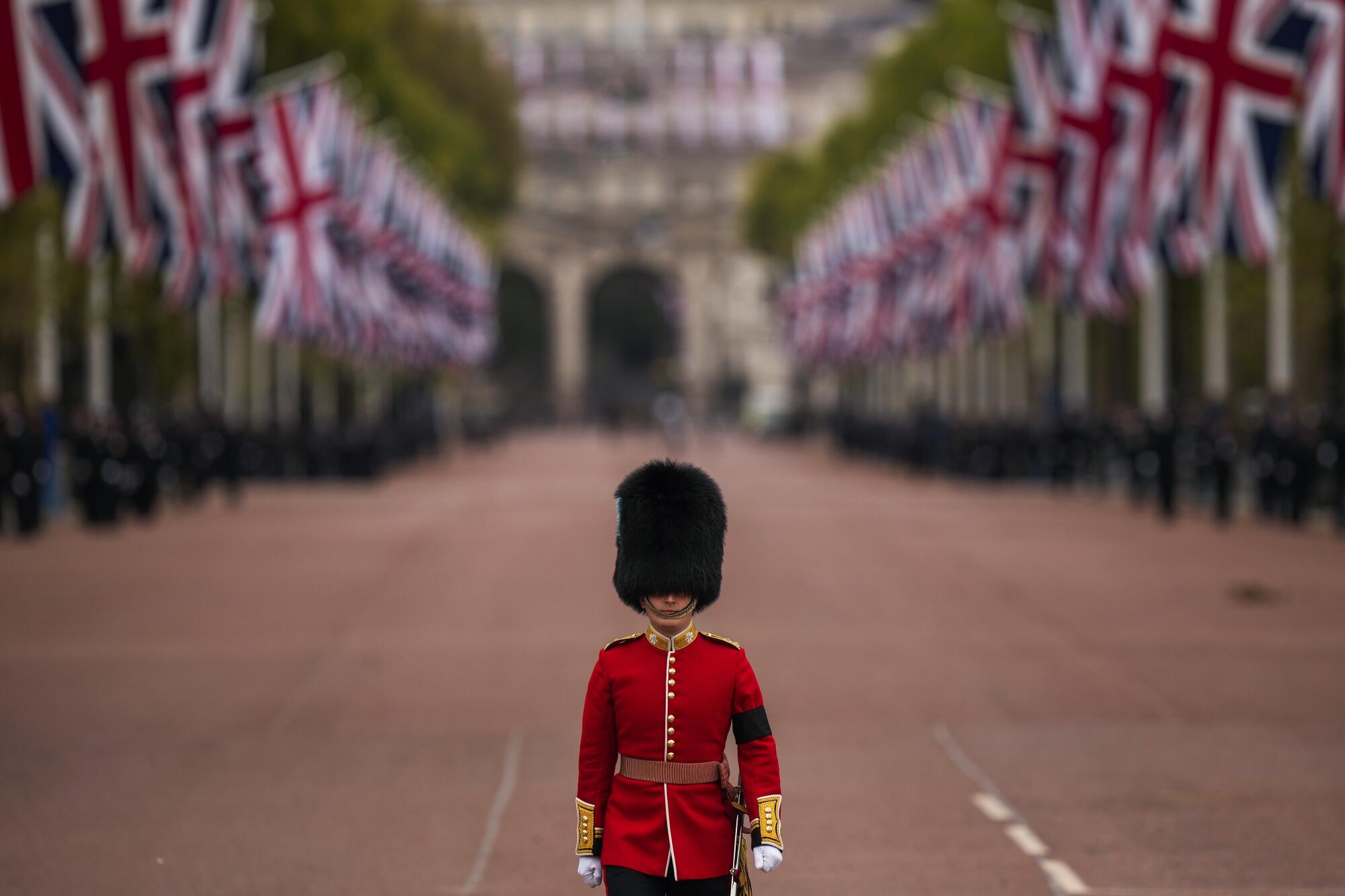
2:11 a.m. Masses of people gathered early alongside and around the Mall, the wide boulevard leading from Buckingham Palace, crowding security barriers and raising their phones high to try to record some of the proceedings.
The queue to nab a space began in the early morning, and well before 10 a.m. there was no more room. Police told latecomers to head to Hyde Park, where the funeral will be broadcast on a giant screen.
“Nothing to see here, folks. You will not see the procession from here. There is no space. There’s no room in the inn,” bellowed one police officer. —NB
2:07 a.m. The pipes and drums are on the move — the Massed Pipes and Drums band from Scottish and Irish regiments will lead the procession of the queen’s coffin from Westminster Hall to Westminster Abbey and, eventually, Windsor Castle. There the queen will approach her final resting place to “The Skye Boat Song,” which was used as the theme song for “Outlander.” It feels just right, somehow. Among many other things, Elizabeth II ushered in a new level of transparency through television, from her coronation to, well, let’s admit it, the fact that many of us already know that she really loved breeding horses because we all watched “The Crown.” —MM

1:47 a.m. A commentator introduces the Band of His Majesty’s Royal Marines, then adds that it takes some getting used to saying “‘His Majesty’ when we have been saying ‘Her Majesty’ for so long.” First lump-in-throat moment. Also, after 70 years of “Queen,” “King” just doesn’t seem to have the same royal ring to it. —MM
1:44 a.m. Westminster Abbey attracts thousands of tourists every year but is of course primarily a place of Christian worship, with a history dating back more than 1,000 years.
It’s neither a cathedral with a bishop nor a regular parish church with a vicar. It’s known as a “royal peculiar,” is run by a dean and is answerable to the British monarch, now King Charles III.
The abbey’s formal name is the Collegiate Church of St. Peter, Westminster. Why “Westminster”? To distinguish this new “west minster” (church) from London’s “east minster,” St. Paul’s Cathedral, whose own history is entwined with the monarchy, including the wedding of then-Prince Charles to Lady Diana Spencer in 1981. —HC
1:37 a.m. Tuned in to coverage of the queen’s funeral at 1 a.m. to images of people taking their seats in Westminster Abbey and BBC anchor Huw Edwards explaining that the 96 tenor bell tolls from Big Ben will soon mark the years of Elizabeth II’s life. Not surprisingly, the coverage quotes John Donne: “Ask not for whom the bell tolls, / It tolls for thee.” A few minutes later, the camera follows Garrison Sgt. Andrew Stokes, who oversaw all of the day’s events, making his solitary way down the Mall, which is lined with British flags. Big Ben begins to echo in the solemn silence. —MM
1:33 a.m. Like President Biden, Indian President Droupadi Murmu on Sunday attended the reception hosted by King Charles III at Buckingham Palace and visited Westminster Hall, where the body of Queen Elizabeth was placed. She offered her tributes and signed the condolence book. President Murmu is India’s first ever tribal president. She hails from a remote tribal district from the state of Orissa. —PMN
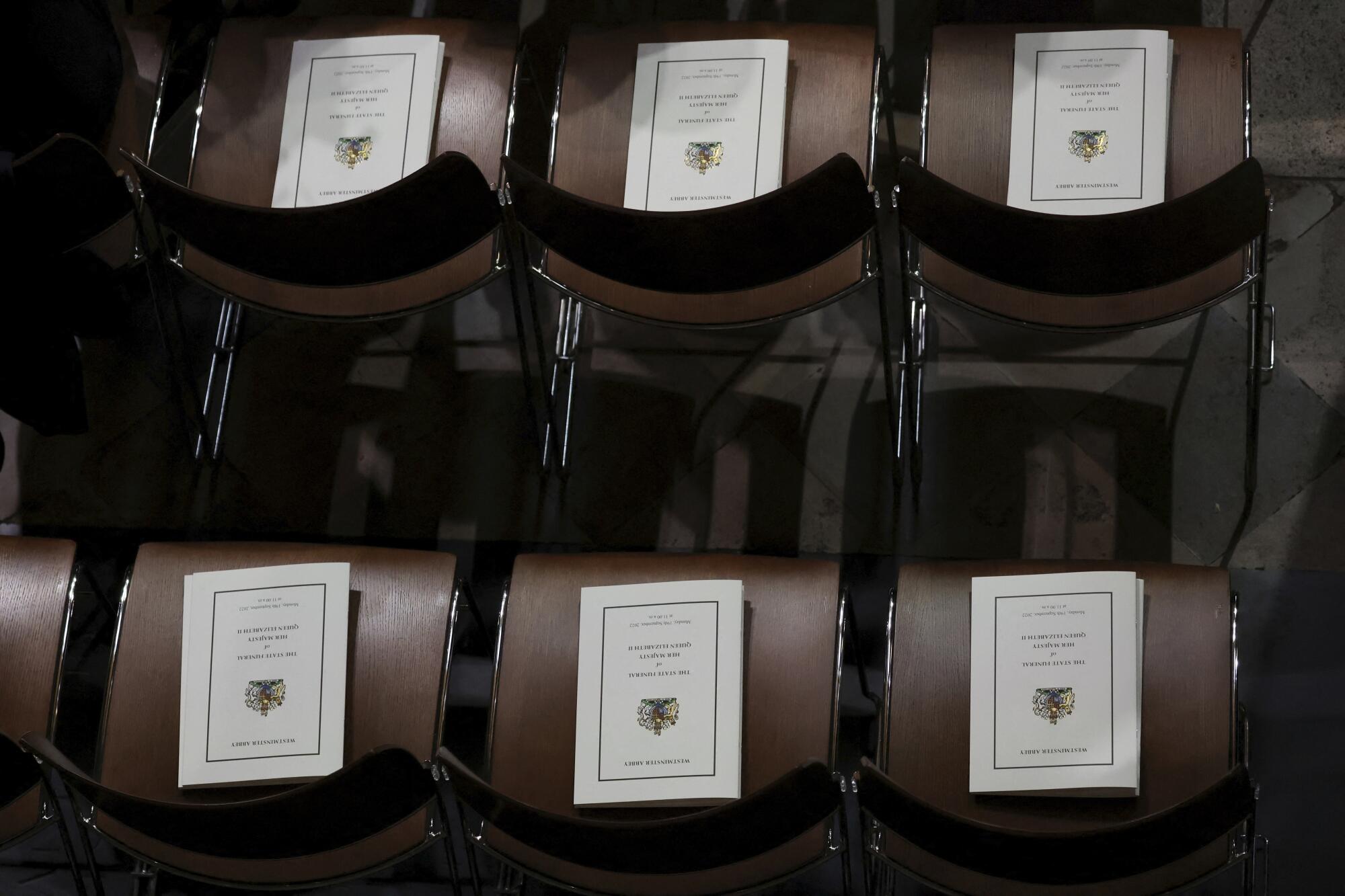
1:10 a.m. Hours before the funeral was set to begin, the formal lying-in-state of the queen’s coffin ended at 6:30 a.m. local time, after hundreds of thousands of mourners filed past over more than four days.
The line, which snaked alongside the Thames, stretched as long as five miles at times, recalling the famous description by a Daily Mail journalist of the crowds that queued to pay respects to Winston Churchill’s casket in 1965: “Two rivers run silently through London tonight and one is made of people.”
By 8 a.m., when the doors of Westminster Abbey were opened for attendees to begin arriving, thousands of people were already thronging nearby streets to watch the coffin’s procession after the service from the abbey to Windsor, where the queen will be buried alongside her husband, Prince Philip. —HC
1:00 a.m. President Biden was among the world leaders who paid tribute to Queen Elizabeth II on Sunday afternoon as she lay in state at London’s Westminster Hall.
The president and First Lady Jill Biden viewed the queen’s coffin from an elevated platform so as not to interrupt the seemingly endless line of people passing through after spending hours in line. He made a sign of the cross and put his hand on his heart as he paid his respects.
Moments later, after signing an official condolence book, Biden made brief comments about the queen, lauding her as a genuine person who reminded him of his own mother, describing her as “decent, honorable, and all about service.”
“To all the people of England, all the people of the United Kingdom, our hearts go out to you,” Biden went on. “And you were fortunate to have had her for 70 years. We all were. The world is better for her.”
Biden, who later attended a private reception at Buckingham Palace hosted by King Charles III, is among the leaders from nearly 200 countries who flew to London for Monday’s funeral.
He plans to return to Washington Monday afternoon, departing immediately after the funeral. Biden’s first meeting with new British Prime Minister Liz Truss was put off until later in the week, when both leaders will be in New York City for the United Nations General Assembly. —ES
More to Read
Sign up for Essential California
The most important California stories and recommendations in your inbox every morning.
You may occasionally receive promotional content from the Los Angeles Times.
